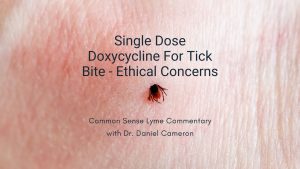Call for your appointment today 914-666-4665 | Mt. Kisco, New York

A study published in April 2021 looked at the frequency of emergency room visits due to tick bites. The authors examined “ED tick bite visits during January 2017-December 2019 by sex, age group, U.S. region, and seasonality,” writes Marx et al. [2] Their findings revealed that tick bites on a child under the age of 9 accounted for the highest number of ED tick bite visits.
During a 36-month period, there were 149,364 ED tick bite visits. The incidence was highest in the Northeast with the larger peak occurring during the spring and early summer, the authors write.
The findings support previous studies which explored the incidence of tick bites among various age groups and the associated risk of exposure to tick-borne diseases.
In 2016, more than 3,000 ticks (n=3551) were submitted to the University of Massachusetts Laboratory of Medical Zoology, as part of a passive surveillance study. The vast majority of ticks provided over a 7–year period were Ixodes scapularis ticks (or blacklegged ticks) from Massachusetts (N ≡ 2088). [3]
Tick bites on a young child pose dangers
Investigators found that children under age 9 had the largest proportion of tick bites. According to Xu and colleagues, 39.7% were identified as nymphs, while 34.6% were adult ticks.
Nearly 200 ticks were collected from children under age 5. Another 200 ticks were collected from children ages 5 to 9. Nearly 90 ticks were collected from adolescents.
Deer ticks were the most common ticks attached to a child. Out of the 3,551 tick bites, 89% were due to deer ticks.
Additionally, 98% of the 1700 adult ticks submitted were female.
The overall infection rate for Borrelia burgdorferi, Anaplasmosis phagocytophilum, and Babesia microti in human-biting ticks were 29.6%, 4.6%, and 1.8%, respectively, writes Xu. Tick bites on a child may lead to more than Lyme disease.
The authors reported ticks harboring multiple infectious agents:
- 1.8% were co-infected by B. burgdorferi and A. phagocytophilum;
- 1.0% were co-infected by B. burgdorferi and B. microti;
- 0.4% were co-infected by A. phagocytophilum and B. microti.
Triple co-infections were found in 0.3% of the ticks.
Note: The investigators did not check for other infections, such as Bartonella henselae or Borrelia miyamotoi.
When do tick bites on children occur?
Tick bites on a child occurred most frequently in the Spring and Fall when children are participating in school activities and sports, explains Xu.
According to the authors, 1700 adult ticks displayed two discrete peaks:
- April – June peak (representing questing activity of the overwintering population)
- October – December peak (representing large autumnal populations)
Between April and October, 360 nymphs were received, with a clear peak in June.
How effective are tick bite prevention methods?
According to several studies, prevention methods are failing our children. One of the most effective ways of measuring whether tick bite prevention methods are working is to monitor the number of tick bites that involve an engorged tick. [4] This is because ticks typically do not become engorged for at least 24 hours.
READ MORE: The dangers in being bitten by a partially fed tick (not fully engorged), where infection is postulated to occur in less than 6 hours. Have you been bitten by a partially fed tick?
Unfortunately, Xu and colleagues found that 35.6% of ticks attached to children younger than 9-years-old were engorged.
This is particularly concerning given that an engorged tick increases your chances of developing Lyme disease by 20 times. [5]
Only 12% of children reported performing regular tick checks.
A school-based intervention program, offered to 1,562 elementary students, explored why children are more likely to get a tick bite. [6] The responses indicate a need for ongoing educational efforts on tick bite prevention measures.
Following are the responses to several of the questions:
How often do you check yourself for ticks?
- 56.8% = sometimes
- 12.0% = always
- 25.8% = usually
Who helps you check for ticks most of the time?
- 77.8% = grown-up at home
- 14.6% = themselves
- 2.0% = grown-up at school checked for ticks
- 4.4% = did not check at all
“As long as there are no effective measures for controlling tick populations and there is no vaccine available, we rely solely on health education and communication efforts to prevent tick bites and Lyme Borreliosis (LB)” writes Beaujean. [7]
“We call on researchers and funders to prioritize research in the field of public health interventions for tick bites and LB,” he writes, “because, in the words of Benjamin Franklin, ‘an ounce of prevention is worth a pound of cure.'”
UPDATED: June 21, 2021
Related Articles:
Powassan virus infection causes polio-like illness
Prevalence of Borrelia infections and Powassan virus in Maine
References:
- Bacon RM, Kugeler KJ, Mead PS. Surveillance for Lyme disease–United States, 1992-2006. MMWR Surveill Summ, 57(10), 1-9 (2008).
- Marx GE, Spillane M, Beck A, Stein Z, Powell AK, Hinckley AF. Emergency Department Visits for Tick Bites – United States, January 2017-December 2019. MMWR Morb Mortal Wkly Rep. 2021 Apr 30;70(17):612-616. doi: 10.15585/mmwr.mm7017a2. PMID: 33914718; PMCID: PMC8084121.
- Xu G, Mather TN, Hollingsworth CS, Rich SM. Passive Surveillance of Ixodes scapularis (Say), Their Biting Activity, and Associated Pathogens in Massachusetts. Vector Borne Zoonotic Dis, 16(8), 520-527 (2016).
- Falco RC, Fish D, Piesman J. Duration of tick bites in a Lyme disease-endemic area. Am J Epidemiol, 143(2), 187-192 (1996).
- Sood SK. Lyme disease in children. Infect Dis Clin North Am, 29(2), 281-294 (2015).
- Shadick NA, Zibit MJ, Nardone E, DeMaria A, Jr., Iannaccone CK, Cui J. A School-Based Intervention to Increase Lyme Disease Preventive Measures Among Elementary School-Aged Children. Vector Borne Zoonotic Dis, 16(8), 507-515 (2016).
- Beaujean D, Crutzen R, Kengen C, van Steenbergen J, Ruwaard D. Increase in Ticks and Lyme Borreliosis, Yet Research into Its Prevention on the Wane. Vector Borne Zoonotic Dis, 16(5), 349-351 (2016).




More attention should be paid to pre treatment of play areas and yards with pesticides that control tick populations. Befenthrin is most effective and easily applied by home owners.
I can’t go feedback on Bifenthrin. It has been classified as a “possible human carcinogen” based on an increased incidence of urinary bladder tumors in mice.” per fda at https://www.federalregister.gov/documents/2012/09/14/2012-22772/bifenthrin-pesticide-tolerances#:~:text=Bifenthrin%20is%20classified%20as%20a,urinary%20bladder%20tumors%20in%20mice